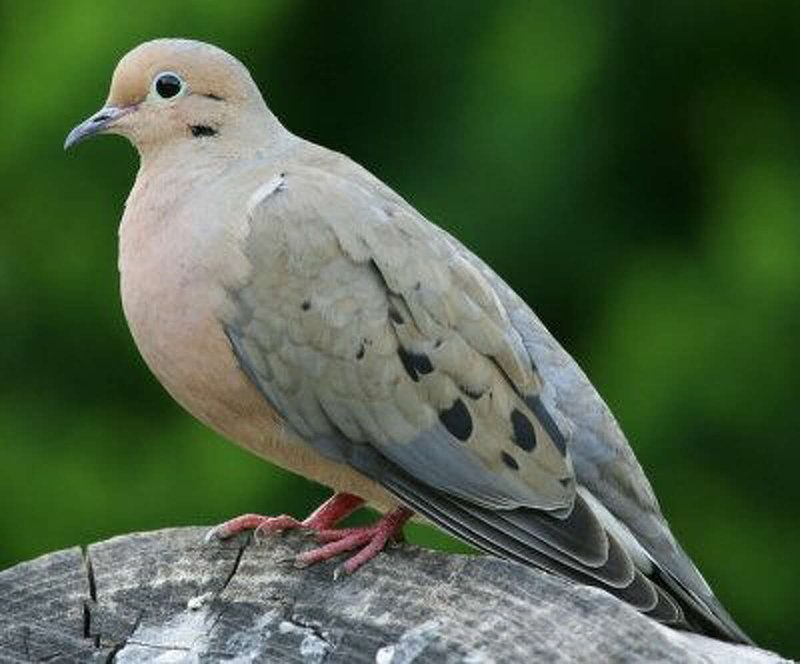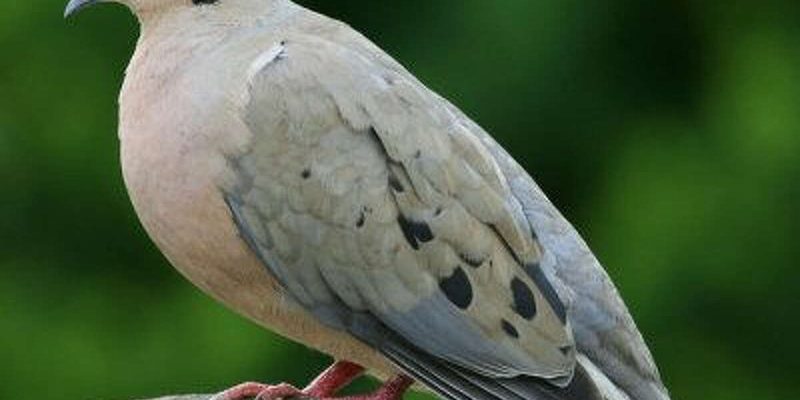
Have you ever heard a soft cooing sound while you were outside, maybe in the park or your backyard? That gentle, melodic noise likely came from a Mourning Dove. These beautiful birds are a common sight across North America, often seen perched on wires, foraging on the ground, or gracefully taking flight. With their sleek bodies and subtle colors, they can easily blend into their surroundings, but their soothing sounds set them apart.
Mourning Doves have a unique place in the ecosystem as both prey and predator. They not only consume seeds and fruits but also provide food for various predators. Their presence indicates a healthy environment, making them significant to the balance of local ecosystems. Whether you’re a bird-watching enthusiast or just curious about the wildlife around you, there’s much to learn about these fascinating creatures.
Physical Characteristics
Mourning Doves are medium-sized birds, typically around 9 to 13 inches long. They have a distinctive slender body with a long, pointed tail and a small head. Their plumage is mostly light gray or brown, sprinkled with subtle shades of pink and buff. One of the beautiful features of the Mourning Dove is its long, tapering tail, which helps them maneuver gracefully in the air.
When it comes to identifying these birds, take note of their eyes: Mourning Doves have bright, dark eyes that can seem quite expressive. Their wings are also notable, with a hint of iridescent color—especially noticeable when they fly. In flight, you might catch a glimpse of their long tail feathers spreading out like fingers, which adds to their elegance.
Table of Facts About the Mourning Dove
| Scientific Name: | Zenaida macroura |
| Size: | 9-13 inches |
| Wingspan: | 17-22 inches |
| Weight: | 4.5-5.4 ounces |
| Diet: | Seeds, fruits, and grains |
| Lifespan: | 1-3 years in the wild; up to 15 years in captivity |
| Habitat: | Open woodlands, grasslands, and urban areas |
Habitat and Distribution
Mourning Doves are extremely adaptable, which is one of the reasons they’re so widespread. You can find them in open woodlands, grasslands, and even urban areas. Their ability to thrive in various environments allows them to inhabit almost all of North America, from southern Canada to Mexico. They prefer areas with plenty of seeds and soft ground for foraging, making parks and gardens ideal spots.
Interestingly, Mourning Doves tend to migrate depending on the seasons. In colder months, they might move southward to warmer climates where food is more abundant. This migration pattern is often an instinctive response to changing temperatures and the availability of food sources. So, if you notice them disappearing from your area during winter, they may be seeking warmer conditions elsewhere.
Diet and Feeding Habits
The diet of a Mourning Dove primarily consists of seeds, grains, and fruits. These birds are often seen foraging on the ground for food, where they peck at various seeds. Their favorites include sunflower seeds, millet, and various grains, which provide them with essential nutrients. You might notice them eating slowly, taking their time to ensure they’ve gathered enough energy to sustain their flight and activities.
Besides foraging, Mourning Doves have a unique way of drinking water. Instead of dipping their beaks into a water source, they’ll take in water by letting it flow into their mouths while they stand in shallow areas. This adaptive behavior further exemplifies their capability to thrive in diverse habitats. It’s quite fascinating how these simple birds have such unique feeding strategies to suit their needs!
Behavior and Social Structure
Mourning Doves are generally social birds, often seen in pairs or small groups. Their cooing calls are frequently heard during courtship, and these sounds can be quite endearing. Males perform an elaborate display that includes bowing and puffing out their chests to attract a mate. Once they form a bond, pairs will typically stay together throughout the breeding season and sometimes for life.
One interesting behavior is how Mourning Doves communicate with one another. Their cooing is not just for attracting mates; it can also serve as a way to warn other doves about potential threats nearby. This vocal communication plays a significant role in their social structure, helping them stay connected in groups. If you’ve ever observed them in your backyard, you’ll notice their interactions are quite dynamic and lively!
Nesting and Reproduction
Mourning Doves have a pretty straightforward approach to nesting. They prefer to build their nests in low shrubs or trees, using twigs, grasses, and other plant materials. The female usually lays two eggs at a time, which are white and slightly glossy. Both parents take turns incubating the eggs, typically for about two weeks until they hatch.
Once the chicks are born, they are altricial, meaning they are born helpless and require significant care. The parents feed them a nutritious fluid known as “pigeon milk,” which is produced in the digestive tract. It’s amazing how quickly these young birds grow, becoming independent and ready to leave the nest in just a couple of weeks.
Mourning Doves in Culture
The gentle nature of Mourning Doves has made them symbols of peace and tranquility in various cultures. Their cooing sounds are often associated with calmness and serenity, embodying a sense of comfort in nature. They appear in literature, art, and even folklore as gentle messengers, often representing love and fidelity.
In many Native American cultures, Mourning Doves hold significant meaning. They are seen as symbols of mourning but also of hope, representing the cycle of life and death. Their soft coos can evoke a feeling of reflection and peace, making them beloved creatures in many communities.
Conservation Status
Mourning Doves are currently not considered endangered, and their populations remain stable across much of their range. However, habitat loss due to urban development and agricultural practices can impact their numbers. Thankfully, efforts to preserve natural habitats and create bird-friendly environments can help maintain their populations.
As a homeowner or nature enthusiast, you can contribute to conservation efforts by creating a welcoming space for Mourning Doves. Providing native plants, shelter, and clean water sources encourages these lovely birds to visit your yard. Engaging in birdwatching is not just a pastime; it can also be a significant step toward supporting local wildlife.
FAQ
What does a Mourning Dove sound like?
Mourning Doves are known for their soft, cooing sounds, which can often be heard during the day. Their calls are gentle and melodious, with a soothing quality that many people find comforting. During courtship, males may produce a series of coos that can be quite lyrical. You might even hear them throughout the day or at dawn and dusk, making their presence known in your area.
Are Mourning Doves migratory birds?
Yes, Mourning Doves are migratory birds. Depending on the season, they may migrate from their northern breeding grounds to warmer southern areas during the winter months. This migration is typically driven by food availability and temperature changes. So, if you notice they are absent in the colder months, it’s likely they’re enjoying a milder climate elsewhere!
How long do Mourning Doves live?
In the wild, the average lifespan of a Mourning Dove is about 1 to 3 years. However, some can live much longer—up to 15 years—if they are in a safe environment, like in captivity. Factors such as predation, habitat conditions, and food availability greatly influence their lifespan in the wild.
What do Mourning Doves eat?
Mourning Doves primarily feed on seeds, grains, and fruits. Some of their favorites include sunflower seeds and millet. They often forage on the ground, pecking around for food, which makes gardens and open fields great places to spot them. They have a unique drinking method, where they take in water by letting it flow into their mouths without dipping their beaks, which is quite remarkable!
Where do Mourning Doves build their nests?
Mourning Doves prefer to build their nests in low trees, shrubs, or even on ledges of buildings. They use twigs, grasses, and other plant materials to create a simple nest that provides shelter and safety for their young. The nests are often placed in sheltered areas to protect against predators. If you keep an eye on your yard, you might find a nest tucked away!
Can I attract Mourning Doves to my backyard?
Absolutely! To attract Mourning Doves, create a friendly environment by providing native plants, bird feeders filled with seeds, and a clean water source. They enjoy open areas where they can easily forage for food. Just be patient; with the right setup, you can enjoy the serene presence of these beautiful birds in your garden.
What threats do Mourning Doves face?
While Mourning Doves are not endangered, they do face threats like habitat loss due to urban development, pesticides, and extreme weather conditions. These factors can impact their food sources and nesting sites. Conservation efforts, such as preserving natural habitats and creating bird-friendly environments, are essential for maintaining their populations and supporting these gentle creatures.
Are Mourning Doves monogamous?
Yes, Mourning Doves are generally monogamous during the breeding season. Once a pair forms a bond, they often stay together to raise their young. They work together in nesting, incubating eggs, and feeding their chicks, which strengthens their partnership. This behavior showcases their strong family dynamics and commitment to their offspring.
How can I identify a Mourning Dove?
Identifying a Mourning Dove is relatively straightforward. Look for their slender body shape, long pointed tail, and light gray or brown plumage. Their characteristic soft cooing sounds also make them stand out. You can often find them perched on telephone wires or foraging on the ground, making them a lovely sight to observe!
Do Mourning Doves migrate alone or in flocks?
Mourning Doves tend to migrate in small groups rather than large flocks. During migration, you may notice them flying in pairs or small clusters. This social behavior helps them stay connected, and they often communicate with one another through their soft cooing sounds, making their migration journeys feel less lonely.
What role do Mourning Doves play in the ecosystem?
Mourning Doves play a significant role in their ecosystem as both prey and seed dispersers. They help control weed populations by consuming seeds and grains, which can promote plant diversity. Additionally, they serve as a food source for various predators, contributing to the natural food web. Their presence in an area indicates a healthy environment, making them vital to the ecosystem’s balance.

